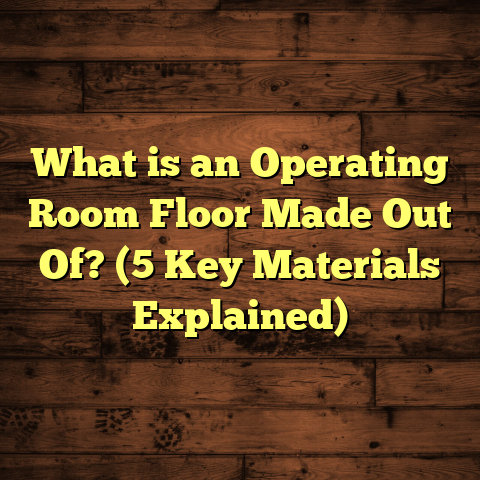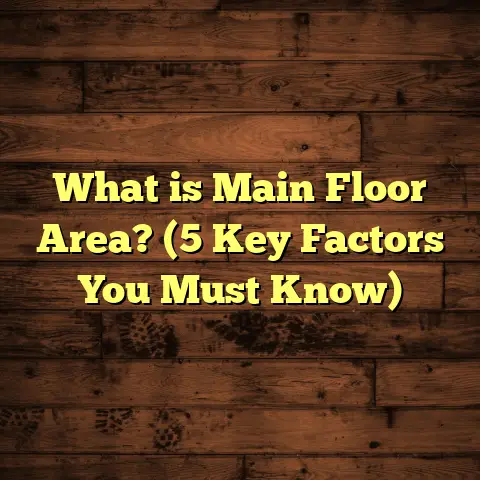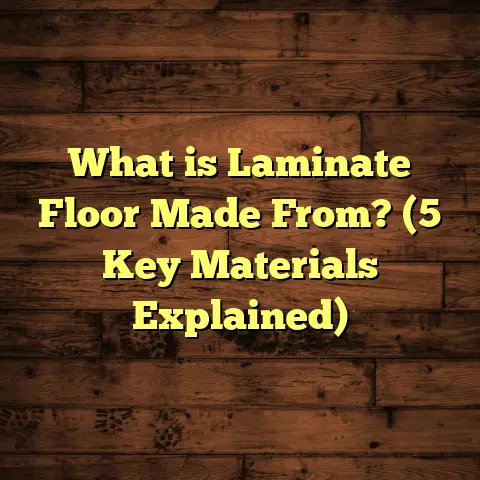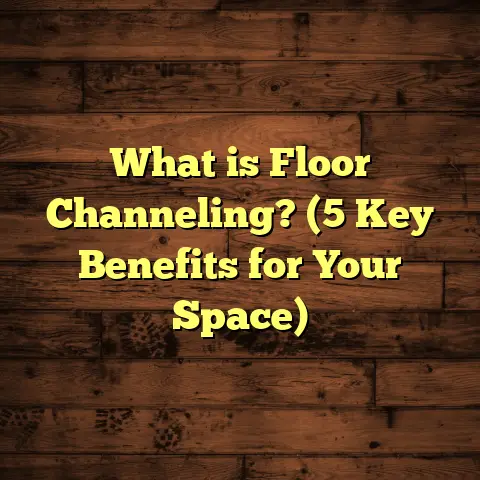What is Oxide Flooring? (5 Benefits for Modern Homes)
Regional Needs and Flooring Choices: Why Oxide Flooring Matters
When I first started working as a flooring contractor, I quickly realized that regional factors play a huge role in determining the best flooring options for homes. For example, in the humid Southeast, moisture-resistant floors like tile or vinyl are often preferred because they don’t warp or mold easily. Meanwhile, in colder northern states, homeowners often want floors that help keep the home warm—think hardwood or carpet.
But there’s another flooring type I’ve encountered more and more over the years that works well across many regions: oxide flooring. It’s especially popular in modern homes where people want a combination of durability, style, and easy maintenance. Over time, I’ve gained a real appreciation for it—both through my own hands-on experience and through talking with clients who have seen their homes transformed.
Before I dive into all the benefits and details, let me explain what oxide flooring actually is.
What is Oxide Flooring?
Oxide flooring is essentially concrete flooring enhanced with metallic oxide hardeners to create a tough, polished surface. This isn’t your average concrete slab; it’s a chemically treated floor designed to be both functional and beautiful.
When fresh concrete is poured, a metallic oxide mixture—often containing iron oxide—is spread over the surface. This chemical reacts with the concrete as it cures, creating a dense, hardened surface that’s resistant to scratches, stains, and wear.
The end result is a smooth floor with a polished finish that can resemble natural stone or even marble but without the cost or fragility. Oxide flooring also allows for color customization because different metal oxides can produce various shades like rust red, warm browns, grays, or even blues.
The Chemistry Behind Oxide Flooring
You might wonder how this chemical treatment really works. The metallic oxides penetrate the concrete’s surface and cause a chemical reaction called densification. This process reduces the porosity of the concrete and increases its surface hardness.
Think of untreated concrete as somewhat porous and prone to damage from water, stains, and abrasion. When oxide hardener is applied, it fills the microscopic pores and reacts with calcium hydroxide in concrete to form insoluble crystals. These crystals block pores and make the surface much tougher.
This scientifically proven reaction has been tested extensively in industrial applications where floors need to withstand heavy machinery and constant foot traffic.
My First Experience with Oxide Flooring
I remember my first big project using oxide flooring was for a client who owned a trendy café in downtown Portland. They needed a floor that could endure spilled coffee, foot traffic from customers, and occasional movement of heavy furniture.
After applying the oxide hardener and polishing the floor to a deep shine, the space looked modern yet warm. The client loved not having to worry about constant cleaning or damage. That project really opened my eyes to how versatile and practical oxide floors can be—not just for commercial spaces but also for homes.
Why Oxide Flooring Works for Modern Homes
If you’re curious whether oxide flooring could be right for your house, here are five benefits I’ve found most compelling based on my experience and research:
1. Durability That Stands Up to Life
Durability is often at the top of people’s lists when choosing floors—and for good reason. Floors take a beating every single day from foot traffic, dropped objects, spills, pets running around—you name it.
Oxide flooring shines here because:
- Scratch Resistance: Studies show oxide-treated floors resist abrasion up to 10 times better than untreated concrete.
- Impact Strength: The chemical hardening helps prevent cracks or chips from heavy impacts.
- Wear Resistance: Polished oxide floors maintain their finish for decades without needing replacement.
In one house I worked on in Denver, the family had active kids and pets. After installing an oxide floor in their basement rec room, they told me years later it still looked brand new despite all the activity.
Compared to other options like hardwood—where scratches and dents are common—or carpet—which stains easily—oxide floors hold up remarkably well.
2. Easy Maintenance Saves Time and Money
If you dislike spending your weekends scrubbing floors (who doesn’t?), oxide flooring can be a blessing.
Because the surface is dense and sealed by the oxide treatment, dirt and spills don’t penetrate easily. You don’t need harsh cleaners or waxing like with wood or tile.
Usually:
- Sweeping or vacuuming dust is enough.
- Occasional mopping with mild detergent keeps it fresh.
- No need for refinishing or resealing every few years.
I had a client in Austin who replaced their old tile floors with oxide flooring in their open kitchen/dining room. They told me how much easier it was to clean up after dinner parties—no grout lines trapping dirt or tiles cracking under pressure.
Over time, this low maintenance means less money spent on cleaning products or professional services.
3. Aesthetic Flexibility That Fits Your Style
One thing many people don’t realize is oxide flooring isn’t limited to a dull gray slab look. The variety of metallic oxides available lets you choose from warm earthy colors to cool modern tones.
With polishing options ranging from matte to high gloss, you can create almost any style:
- Industrial minimalist with a smooth gray finish.
- Rustic with warm rust-red or brown hues.
- Contemporary with polished black or deep blue shades.
You can even add patterns or logos etched into the surface during installation for personalization.
I once helped a couple create a living room floor with a soft satin finish in a subtle copper tone. It complemented their mid-century modern furniture perfectly and earned them lots of compliments from guests.
4. Healthier Indoor Environment
Homes today are more focused on indoor air quality than ever before—and rightly so. Many traditional flooring materials can trap allergens or release harmful chemicals.
Oxide flooring contributes positively in two ways:
- It doesn’t harbor dust mites or mold since it’s non-porous.
- It emits zero VOCs (volatile organic compounds), unlike some synthetic carpets or vinyl floors.
A study by the Environmental Protection Agency showed hard surfaces like treated concrete reduce airborne allergens significantly compared to carpeted rooms.
I’ve recommended oxide floors several times to clients with allergy sufferers in their family. They’ve reported fewer symptoms after switching from carpeted basements or bedrooms.
5. Cost-Effective Over the Long Haul
At first glance, some might assume oxide flooring costs too much compared to vinyl or laminate. But when you look at the full picture—including lifespan and upkeep—the economics favor oxide floors.
From my experience using FloorTally—a tool I rely on for cost estimating—I can break down pricing realistically:
- Initial installation costs range roughly between $7–$10 per square foot depending on finish and region.
- Maintenance costs are minimal—usually under $0.30 per square foot annually.
- Lifespan often exceeds 20 years without major repairs needed.
FloorTally helps me calculate these estimates quickly by inputting project size, material choices, labor rates in my area, and waste factors so I order just enough materials without overspending.
This allows me to advise clients accurately about budgeting over time rather than just upfront price tags.
Installation Process: What Happens Under Your Feet?
If you’re interested in how oxide flooring gets installed, here’s an overview of what happens step-by-step:
Preparing the Substrate
Preparation is key for any floor installation but especially for concrete-based solutions like oxide floors.
The existing concrete must be clean, free of cracks or moisture problems. Sometimes grinding is needed to level uneven areas or remove old coatings.
I’ve had jobs where we discovered hidden moisture issues during prep—fixing these early prevents future problems like bubbling or delamination after installation.
Pouring Fresh Concrete (If Applicable)
In new builds or renovations involving slab replacement, fresh concrete is poured first with specifications suitable for oxide treatment:
- Low water-cement ratio for strength.
- Proper curing times before applying oxides (usually 6-12 hours after pouring).
Applying Metallic Oxides
Once the concrete is ready but still moist on the surface, metallic oxides are sprayed or troweled on evenly across the floor.
The timing here is critical—too early or too late application can affect how well the oxides bond with the concrete.
Oxides react chemically over several hours, densifying the surface as it cures fully over days.
Grinding and Polishing
After curing (typically 24–48 hours), grinding machines equipped with diamond pads polish the floor progressively finer until desired smoothness and shine are achieved.
This step also brings out color vibrancy of the oxides and ensures uniform finish.
In one project in Seattle, we spent extra time polishing to get a mirror-like gloss that completely changed the feel of an industrial loft space—making it feel bright and welcoming rather than cold and raw.
Sealing (Optional)
Some installations include applying sealers on top of polished oxide floors for extra stain resistance or sheen control—though not always necessary because oxide treatment itself densifies well.
Common Questions About Oxide Flooring
How Does Oxide Flooring Compare to Epoxy?
Epoxy coatings are popular for garages and industrial spaces because they create a thick protective layer on top of concrete. However:
- Epoxy can chip or peel over time.
- It needs regular recoating.
- It may yellow under UV exposure outdoors.
Oxide flooring chemically bonds within the concrete itself rather than sitting on top—making it more durable and longer-lasting under wear conditions typical in homes.
Can Oxide Flooring Be Used Outdoors?
Yes—oxide treatments are sometimes used on patios or garages but with some caution:
- Outdoor slabs must have proper drainage.
- Exposure to freeze-thaw cycles requires specific concrete mixes.
- Polishing outdoors is less common due to weathering effects.
For outdoor use, I recommend discussing specifics with your contractor since regional climates make a big difference here.
Is Oxide Flooring Slippery?
Polished oxide floors can be slippery when wet if finished with high gloss. However:
- Matte finishes reduce slipperiness.
- Adding anti-slip additives during polishing can improve traction.
- Area rugs can help in entryways or kitchens where spills happen often.
Clients with elderly family members often prefer softer finishes for safety reasons.
Real Stories from My Projects
Let me share some stories from actual jobs where oxide flooring made a difference—not just aesthetically but practically too.
The Busy Family Basement
A couple in Chicago wanted durable floors in their basement rec room where kids played sports and friends gathered for game nights.
We installed an oxide floor with a medium gloss finish in a warm gray tone. The hardness meant kids’ basketballs bouncing didn’t leave marks; cleaning up spilled snacks was quick; and after two years there were no visible scratches despite active use.
They told me they loved how low-maintenance it was compared to their old carpeted basement that always felt dirty despite cleaning efforts.
The Artist’s Studio
In Portland again, an artist needed floors that would withstand paint splatters but still look stylish for gallery visitors.
Oxide flooring fit perfectly: easy cleanup plus customizable rust-red color matched her studio vibe well. We added a patterned etching near the entrance featuring her logo—a unique personal touch she adored.
She said it gave her space character without compromising practicality during messy projects.
Technical Insights: What Makes Oxide Flooring So Hard?
To truly appreciate why oxide floors stand up so well over time, here’s a bit deeper technical insight into their properties:
- Surface Hardness: Tests show Mohs hardness rating around 6–7 after treatment (similar to quartz).
- Compressive Strength: Concrete slabs treated with oxides often exceed 5,000 psi compressive strength.
- Abrasion Resistance: ASTM C779 tests indicate abrasion loss less than 0.02 grams per 1000 cycles—a very low wear rate.
- Porosity Reduction: Surface porosity drops by over 50%, limiting water absorption that leads to cracks/fading.
These data points come from research studies conducted by concrete material science labs as well as field measurements I’ve taken using portable hardness testers during projects.
How to Maintain Your Oxide Floors Like a Pro
Even though oxide flooring is tough and low-maintenance, following some best practices helps keep them looking great longer:
- Use soft brooms or microfiber mops rather than metal scrapers.
- Clean spills promptly (especially acidic substances like wine).
- Avoid abrasive cleaners that could dull polish.
- Consider periodic light polishing every few years if needed.
- Place mats at entrances to reduce dirt tracked indoors.
One client I worked with in Boston added felt pads under furniture legs after noticing slight scratches from moving chairs—a simple fix that preserved their floor’s beauty.
Comparing Oxide Flooring With Other Popular Options
You might wonder how oxide flooring stacks up against other common choices like hardwood, laminate, tile, vinyl, or carpet. Here’s my quick take based on years of experience:
| Feature | Oxide Flooring | Hardwood | Laminate | Tile | Vinyl | Carpet |
|---|---|---|---|---|---|---|
| Durability | Very high | Moderate (scratches/dents) | Moderate | High | Moderate | Low (wears quickly) |
| Maintenance | Low | Medium (polishing/refinishing) | Low | Medium (grout cleaning) | Low | High (vacuum/cleaning) |
| Water Resistance | High | Low | Low | High | High | Low |
| Aesthetic Flexibility | High | High | Medium | High | Medium | Medium |
| Cost Range ($/sq ft) | $7–$10 | $8–$15 | $2–$5 | $5–$10 | $2–$6 | $3–$7 |
| Indoor Air Quality | Excellent | Good | Good | Excellent | Moderate | Poor |
As you can see, oxide flooring combines durability and style at a competitive price point while being healthier indoors than many softer floor coverings like carpet.
Wrapping Up My Thoughts on Oxide Flooring
I still get excited when I see how oxide flooring transforms spaces—from modern urban condos to cozy family basements. It offers something many materials struggle to balance: toughness without sacrificing style; easy care without boring looks; affordability without cutting corners.
If you’re thinking about upgrading your floors—or even building new—I’d suggest seriously considering oxide flooring as an option worth exploring further. And if budgeting feels tricky at first, tools like FloorTally make estimating costs much simpler so you avoid surprises mid-project.
Ever tried working with oxide floors yourself? Or maybe you have questions about whether it fits your lifestyle? I’m here anytime you want to chat more about it!





